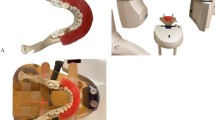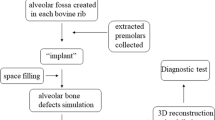Abstract
Objectives
This study aimed to assess the effect of voxel size on detection of fenestration, dehiscence, and furcation defects using cone-beam computed tomography (CBCT).
Materials and methods
This in vitro, experimental study evaluated 4 sheep skulls with both the maxilla and mandible accompanied by the surrounding soft tissue. Fenestration (n = 30), dehiscence (n = 65), and furcation defects (n = 46; 18 grade I, 25 grade II, and 3 grade III) were randomly created by round and needle burs in both jaws, and 40 areas served as control sites. CBCT scans were obtained with 0.300 and 0.150 mm3 voxel sizes and 8 × 11cm2 field of view (FOV), and were randomly observed by four observers (two oral and maxillofacial radiologists and two periodontists). The kappa values, sensitivity and specificity were calculated for each voxel size and compared using paired t test.
Results
By an increase in image resolution, diagnostic sensitivity increased while specificity decreased. The kappa values for fenestration (0.602–0.623), and grade III furcation defects (0.903–1.00) were optimal (> 0.6), and almost similar for both voxel sizes. The kappa values for dehiscence, and grades I and II furcation defects were unfavorable (< 0.6) and almost similar for both voxel sizes, except for grade I furcation defects, which had a significant difference in kappa values between the two voxel sizes (0.014 and 0.34).
Conclusion
Smaller voxel size had higher sensitivity and lower specificity for detection of all defects except for grade I furcation defects, for which the smaller voxel size had higher sensitivity and higher specificity.



Similar content being viewed by others
References
Offenbacher S. Periodontal diseases: pathogenesis. Ann Periodontol. 1996;1(1):821–78. https://doi.org/10.1902/annals.1996.1.1.821.
Sun Z, Smith T, Kortam S, Kim DG, Tee BC, Fields H. Effect of bone thickness on alveolar bone-height measurements from cone-beam computed tomography images. Am J Orthod Dentofacial Orthop. 2011;139(2):e117–27. https://doi.org/10.1016/j.ajodo.2010.08.016.
Albandar JM, Rams TE. Global epidemiology of periodontal diseases: an overview. Periodontol. 2000;2002(29):7–10. https://doi.org/10.1034/j.1600-0757.2002.290101.x.
Kamburoglu K, Murat S, Kilic C, Yuksel S, Avsever H, Farman A, et al. Accuracy of CBCT images in the assessment of buccal marginal alveolar peri-implant defects: effect of field of view. Dentomaxillofac Radiol. 2014;43(4):20130332. https://doi.org/10.1259/dmfr.20130332.
de-Azevedo-Vaz SL, Vasconcelos Kde F, Neves FS, Melo SL, Campos PS, Haiter-Neto F. Detection of periimplant fenestration and dehiscence with the use of two scan modes and the smallest voxel sizes of a cone-beam computed tomography device. Oral Surg Oral Med Oral Pathol Oral Radiol. 2013;115(1):121–7. https://doi.org/10.1016/j.oooo.2012.10.003.
Ding Q, Zhang L, Geraets W, Wu W, Zhou Y, Wismeijer D, et al. Association between peri-implant bone morphology and marginal bone loss: a retrospective study on implant-supported mandibular overdentures. Int J Oral Maxillofac Implants. 2017;32(1):147–55. https://doi.org/10.11607/jomi.4922.
Jeffcoat MK. Current concepts in periodontal disease testing. J Am Dent Assoc. 1994;125(8):1071–8. https://doi.org/10.14219/jada.archive.1994.0136.
Reddy MS. Radiographic methods in the evaluation of periodontal therapy. J Periodontol. 1992;63(Suppl 12S):1078–84. https://doi.org/10.1902/jop.1992.63.12s.1078.
Tyndall DA, Rathore S. Cone-beam CT diagnostic applications: caries, periodontal bone assessment, and endodontic applications. Dent Clin North Am. 2008;52(4):825–41. https://doi.org/10.1016/j.cden.2008.05.002 ((vii)).
Tugnait A, Clerehugh V, Hirschmann PN. The usefulness of radiographs in diagnosis and management of periodontal diseases: a review. J Dent. 2000;28(4):219–26. https://doi.org/10.1016/s0300-5712(99)00062-7.
Braun X, Ritter L, Jervoe-Storm PM, Frentzen M. Diagnostic accuracy of CBCT for periodontal lesions. Clin Oral Investig. 2014;18(4):1229–36. https://doi.org/10.1007/s00784-013-1106-0.
Mol A. Imaging methods in periodontology. Periodontol. 2000;2004(34):34–48. https://doi.org/10.1046/j.0906-6713.2003.003423.x.
Jeffcoat MK, Wang IC, Reddy MS. Radiographic diagnosis in periodontics. Periodontol. 2000;1995(7):54–68. https://doi.org/10.1111/j.1600-0757.1995.tb00036.x.
Meyer MS, Joshipura K, Giovannucci E, Michaud DS. A review of the relationship between tooth loss, periodontal disease, and cancer. Cancer Causes Control. 2008;19(9):895–907. https://doi.org/10.1007/s10552-008-9163-4.
Vandenberghe B, Jacobs R, Yang J. Diagnostic validity (or acuity) of 2D CCD versus 3D CBCT-images for assessing periodontal breakdown. Oral Surg Oral Med Oral Pathol Oral Radiol Endod. 2007;104(3):395–401. https://doi.org/10.1016/j.tripleo.2007.03.012.
SD B, A L. 2Dand 3D images generated by cone beam computed tomography (CBCT) for dentomaxillofacial investigations. In: CARS ’98 Proceedings of the 12th international Symposium and Exhibition: Computer Assisted Radiology and Surgery Amsterdam: Elsevier. 1998:792–7.
Fuhrmann RA, Wehrbein H, Langen HJ, Diedrich PR. Assessment of the dentate alveolar process with high resolution computed tomography. Dentomaxillofac Radiol. 1995;24(1):50–4. https://doi.org/10.1259/dmfr.24.1.8593909.
Bayat S, Talaeipour AR, Sarlati F. Detection of simulated periodontal defects using cone-beam CT and digital intraoral radiography. Dentomaxillofac Radiol. 2016;45(6):20160030. https://doi.org/10.1259/dmfr.20160030.
Katsumata A, Hirukawa A, Okumura S, Naitoh M, Fujishita M, Ariji E, et al. Relationship between density variability and imaging volume size in cone-beam computerized tomographic scanning of the maxillofacial region: an in vitro study. Oral Surg Oral Med Oral Pathol Oral Radiol Endod. 2009;107(3):420–5. https://doi.org/10.1016/j.tripleo.2008.05.049.
Ballrick JW, Palomo JM, Ruch E, Amberman BD, Hans MG. Image distortion and spatial resolution of a commercially available cone-beam computed tomography machine. Am J Orthod Dentofacial Orthop. 2008;134(4):573–82. https://doi.org/10.1016/j.ajodo.2007.11.025.
Da Silveira PFFM, Oliveira HW, Vizzotto MB, Montagner F, Silveira HL, et al. CBCT-based volume of simulated root resorption—influence of FOV and voxel size. Int Endod J. 2015;48(10):959–65.
Kamburoglu K, Murat S, Kolsuz E, Kurt H, Yuksel S, Paksoy C. Comparative assessment of subjective image quality of cross-sectional cone-beam computed tomography scans. J Oral Sci. 2011;53(4):501–8. https://doi.org/10.2334/josnusd.53.501.
Kolsuz ME, Bagis N, Orhan K, Avsever H, Demiralp KO. Comparison of the influence of FOV sizes and different voxel resolutions for the assessment of periodontal defects. Dentomaxillofac Radiol. 2015;44(7):20150070. https://doi.org/10.1259/dmfr.20150070.
Obuchowski NA, Zhou XH. Prospective studies of diagnostic test accuracy when disease prevalence is low. Biostatistics. 2002;3(4):477–92. https://doi.org/10.1093/biostatistics/3.4.477.
Li J, Fine J. On sample size for sensitivity and specificity in prospective diagnostic accuracy studies. Stat Med. 2004;23:2537–50.
Machin D, Campbell MJ, Tan SB, Tan SH Sample Size Tables for Clinical Studies, . Wiley-Blackwell, Chichester, United Kingdom. 2008;Third Edition.
Zhou XH, Obuchowski, p.n.A., McClish, D.K. Statistical Methods in Diagnostic Medicine. Wiley-Interscience, New York. 2002.
Schork MaW, G. Number of Observations Required for the Comparison of Two CorrelatedProportions. Commun Stat-Simula Computa, 1980;B9(4), 349–57.
Cohen. A Coefficient of Agreement for Nominal Scales Educ Psychol Meas. SAGE Publications Inc. 1960;20:37–46.
Fleiss JL, Levin B, Paik MC, Statistical Methods for Rates and proportions. . New YorkWily. 2003;3rd ed.
Miracle AC, Mukherji SK. Conebeam CT of the head and neck, part 2: clinical applications. AJNR Am J Neuroradiol. 2009;30(7):1285–92. https://doi.org/10.3174/ajnr.A1654.
Angelopoulos C, Scarfe WC, Farman AG. A comparison of maxillofacial CBCT and medical CT. Atlas Oral Maxillofac Surg Clin North Am. 2012;20(1):1–17. https://doi.org/10.1016/j.cxom.2011.12.008.
Spin-Neto R, Gotfredsen E, Wenzel A. Impact of voxel size variation on CBCT-based diagnostic outcome in dentistry: a systematic review. J Digit Imaging. 2013;26(4):813–20. https://doi.org/10.1007/s10278-012-9562-7.
Miracle AC, Mukherji SK. Conebeam CT of the head and neck, part 1: physical principles. AJNR Am J Neuroradiol. 2009;30(6):1088–95. https://doi.org/10.3174/ajnr.A1653.
Icen M, Orhan K, Seker C, Geduk G, Cakmak Ozlu F, Cengiz MI. Comparison of CBCT with different voxel sizes and intraoral scanner for detection of periodontal defects: an in vitro study. Dentomaxillofac Radiol. 2020. https://doi.org/10.1259/dmfr.20190197.
Bagis N, Eren H, Kolsuz ME, Kurt MH, Avsever H, Orhan K. Comparison of the burr and chemically induced periodontal defects using different field-of-view sizes and voxel resolutions. Oral Surg Oral Med Oral Pathol Oral Radiol. 2018;125(3):260–7. https://doi.org/10.1016/j.oooo.2017.11.010.
de Faria VK, Evangelista KM, Rodrigues CD, Estrela C, de Sousa TO, Silva MA. Detection of periodontal bone loss using cone beam CT and intraoral radiography. Dentomaxillofac Radiol. 2012;41(1):64–9. https://doi.org/10.1259/dmfr/13676777.
de Faria VKEK, Rodrigues CD, Estrela C, de Sousa TO, Silva MA. Detection of periodontal bone loss using cone beam CT and intraoral radiography. Dentomaxillofac Radiol. 2012;41(1):64–9.
Kamburoglu K, Eres G, Akgun C, Yeta EN, Gulen O, Karacaoglu F. Effect of voxel size on accuracy of cone beam computed tomography-aided assessment of periodontal furcation involvement. Oral Surg Oral Med Oral Pathol Oral Radiol. 2015;120(5):644–50. https://doi.org/10.1016/j.oooo.2015.07.030.
Acknowledgements
The authors would like to thank Dr. Zahra Alizadeh Tabari, Dr. Mina Taheri, and Dr. Golshan Jamali for their sincere cooperation in the conduction of this study.
Author information
Authors and Affiliations
Corresponding author
Additional information
Publisher's Note
Springer Nature remains neutral with regard to jurisdictional claims in published maps and institutional affiliations.
Supplementary Information
Below is the link to the electronic supplementary material.
Rights and permissions
About this article
Cite this article
Eftekhar, M., Kaviani, H., Rouzmeh, N. et al. Effect of voxel size on detection of fenestration, dehiscence and furcation defects using cone-beam computed tomography. Oral Radiol 37, 677–686 (2021). https://doi.org/10.1007/s11282-020-00508-0
Received:
Accepted:
Published:
Issue Date:
DOI: https://doi.org/10.1007/s11282-020-00508-0




